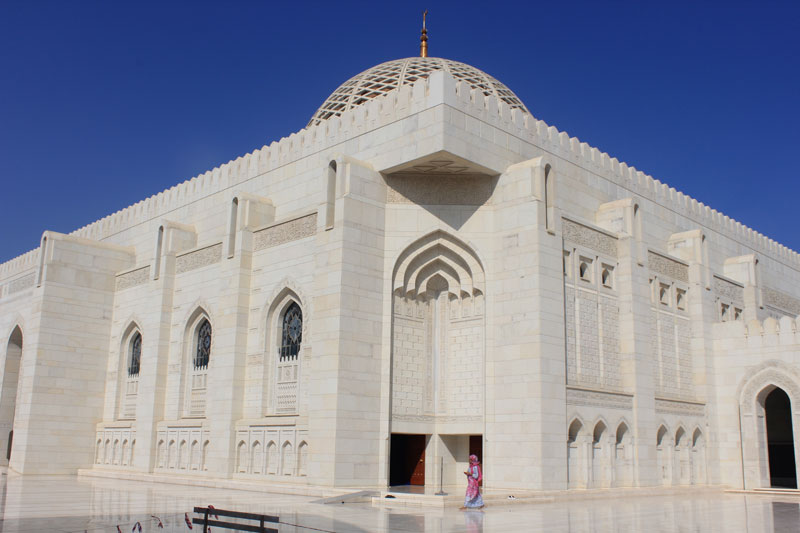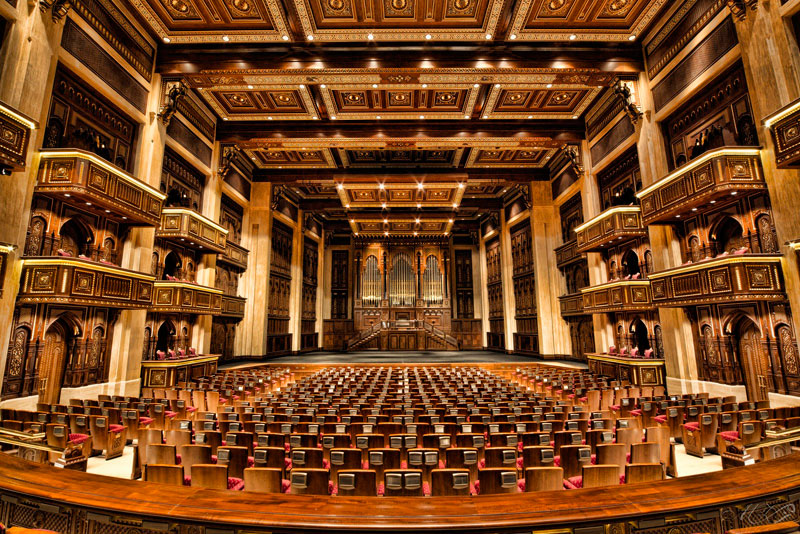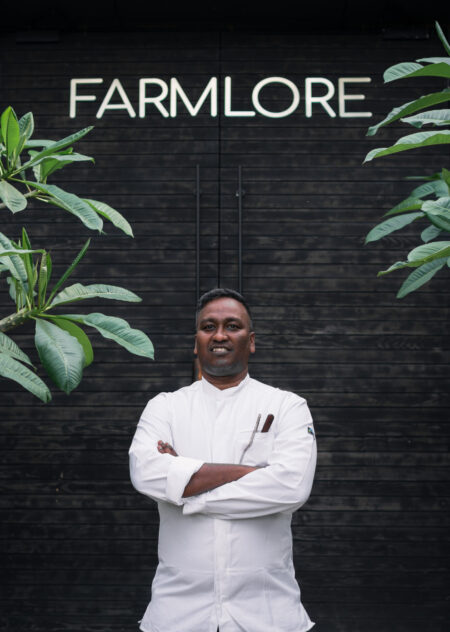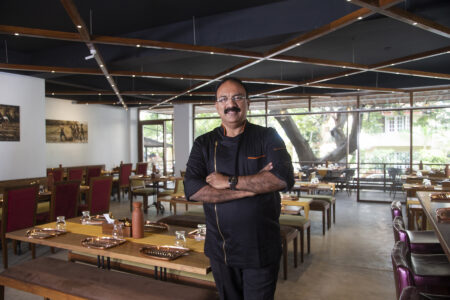The first surprise is from the air. Instead of the flat ripples of desert sand that I was looking for, there are miles of crenellated coastline, weathered rock faces and wrinkled cliffs dropping dramatically to the brilliant blue of the ocean. A little further inland are strips of green vegetation, clusters of houses that blend into the sandy brown of the landscape, large pools of water, and snaking wadis – dried watercourses – prone, I learn later, to seasonal flash floods. I’m gazing at a small chunk of Omani coastline – over 2000 kilometers in all – that has linked the country with Baluchistan, the Indus Valley and Malabar as far back as 3000B.C.  Oman was a nation of sailors, merchants and explorers, of expert shipbuilders and mariners who sailed to China on ships whose planks were held together by just yarn made from coconut bark. They were great navigators and, it is believed that Vasco da Gama’s pilot across the Indian Ocean from Malindi to Calicut was Ahman ibn Majid, an Omani seaman of great repute. For centuries, Oman linked Africa, Asia and the Far East, controlling ocean trade. I wished that I could have approached the Bay of Muscat on a ship to catch my first glimpse of the country through the eyes of countless generations of sailors. Instead, I have to be content with landing at a very compact airport, with the vast sprawl of a new, state of-the-art airport being built, visible some way off.
Oman was a nation of sailors, merchants and explorers, of expert shipbuilders and mariners who sailed to China on ships whose planks were held together by just yarn made from coconut bark. They were great navigators and, it is believed that Vasco da Gama’s pilot across the Indian Ocean from Malindi to Calicut was Ahman ibn Majid, an Omani seaman of great repute. For centuries, Oman linked Africa, Asia and the Far East, controlling ocean trade. I wished that I could have approached the Bay of Muscat on a ship to catch my first glimpse of the country through the eyes of countless generations of sailors. Instead, I have to be content with landing at a very compact airport, with the vast sprawl of a new, state of-the-art airport being built, visible some way off.  The sweep of the Bay of Muscat is another surprise: at either end of the Bay stand two, distinct landmarks, the 16th century Portuguese forts of Mirani and Jalali, with the elegant sprawl of the Al Alam Palace across the seafront, looking out across the waters of the Indian Ocean that Oman dominated for so many centuries. The mellow architecture, which incorporates distinctive elements of ancient Omani building traditions, blends into the landscape, free of the harsh glitter typical of so many modern Gulf cities. This owes much to the vision of Sultan Qaboos bin Said, the Sandhurst educated, progressive ruler who came to power in 1970, and led the transformation of Oman.
The sweep of the Bay of Muscat is another surprise: at either end of the Bay stand two, distinct landmarks, the 16th century Portuguese forts of Mirani and Jalali, with the elegant sprawl of the Al Alam Palace across the seafront, looking out across the waters of the Indian Ocean that Oman dominated for so many centuries. The mellow architecture, which incorporates distinctive elements of ancient Omani building traditions, blends into the landscape, free of the harsh glitter typical of so many modern Gulf cities. This owes much to the vision of Sultan Qaboos bin Said, the Sandhurst educated, progressive ruler who came to power in 1970, and led the transformation of Oman.  In the coming days, we will appreciate the understated beauty of this architecture again and again. In Qurm, with its luxurious private residences and embassies; in Mutrah’s Old Souk; the Corniche, everywhere, the buildings blend into the landscape, so that when the sun dips behind the distant hills, it is as if a wash of peach and sandy beige has been painted across the entire city, and it becomes one with the stony backdrop. Our host, Shawqi Sultan’s home in the Qurm heights is set behind high walls, with a winter garden of marigolds, snapdragons, petunias, and Queen of the Night scenting the air. At Shawqi’s table, classical French dishes and wines blend with lamb shanks and saffron scented rice, and his home, luxurious, modern, incorporates trellises, archways, and the rooftop terrace so perfect for summer nights, all typical of Omani tradition, where guests can sip kahwa, black coffee and orange blossom tea. Cosmopolitan, well travelled and extremely hospitable, Omanis are immensely proud of their distinctive heritage, and always eager to share their knowledge of their country with you, and the conversation around Shawqi Sultan’s table is varied and enriching.
In the coming days, we will appreciate the understated beauty of this architecture again and again. In Qurm, with its luxurious private residences and embassies; in Mutrah’s Old Souk; the Corniche, everywhere, the buildings blend into the landscape, so that when the sun dips behind the distant hills, it is as if a wash of peach and sandy beige has been painted across the entire city, and it becomes one with the stony backdrop. Our host, Shawqi Sultan’s home in the Qurm heights is set behind high walls, with a winter garden of marigolds, snapdragons, petunias, and Queen of the Night scenting the air. At Shawqi’s table, classical French dishes and wines blend with lamb shanks and saffron scented rice, and his home, luxurious, modern, incorporates trellises, archways, and the rooftop terrace so perfect for summer nights, all typical of Omani tradition, where guests can sip kahwa, black coffee and orange blossom tea. Cosmopolitan, well travelled and extremely hospitable, Omanis are immensely proud of their distinctive heritage, and always eager to share their knowledge of their country with you, and the conversation around Shawqi Sultan’s table is varied and enriching. 
The Portuguese admiral, Alfonso de Albuquerque wrote about Muscat: “It is a very fine town, with very fines houses” but it did not stop him from sacking Muscat thoroughly, in 1507!
The day after we arrive, we cut across the gaunt countryside, travelling West towards Nizwa, the old capital of Oman, on a superb highway. The hills are striated, covered with loose gravel, witness to millions of years of tectonic activity, which also gave Oman some of its most stunning natural beauty. The hills change colour with every mile sometimes amethyst, sometimes verdigris; on our return, an almost full, chalky moon turns a pale apricot and the hills glow in shades of old rose. Everywhere, there are old watchtowers and fortifications, speaking of the many generations of wars and feuds fought by tribes in this country.
 The narrow streets of Nizwa are dominated by the 12th century Fort, with its massive, Great Round Tower. We wander around the old Souk, with its attractive displays of terracotta pots strung from date palm trees, browse a jumble of unattractive crafts, typical of tourist haunts, and admire beautiful Omani silver. It’s past noon, and the Souk is quiet, the main business over in the morning. Outside a small shop hangs a brief sign that says ‘halwa’. We wander in, and the friendly owner offers a taste; it’s made with palm sugar, soft, rich and flavoured with cardamom, scented with rosewater and absolutely delicious. Before he knows it, we buy several boxes each and the halwa is sold out. As we emerge with our packages, a man carving a small chest captures my attention – behind him is a pile of wooden chests with brass studs, decorated with sheet work and elaborate trims. These are replicas of the much sought after wooden chests that were once stacked in the holds of Arab dhows that plied the waters between Africa, the Middle East and India. Basra chests; Zanzibar boxes; Suratis – they went by many names, and seeing them so far inland brings a whiff of the thriving ocean trade that once made Oman’s ports the richest in the world.
The narrow streets of Nizwa are dominated by the 12th century Fort, with its massive, Great Round Tower. We wander around the old Souk, with its attractive displays of terracotta pots strung from date palm trees, browse a jumble of unattractive crafts, typical of tourist haunts, and admire beautiful Omani silver. It’s past noon, and the Souk is quiet, the main business over in the morning. Outside a small shop hangs a brief sign that says ‘halwa’. We wander in, and the friendly owner offers a taste; it’s made with palm sugar, soft, rich and flavoured with cardamom, scented with rosewater and absolutely delicious. Before he knows it, we buy several boxes each and the halwa is sold out. As we emerge with our packages, a man carving a small chest captures my attention – behind him is a pile of wooden chests with brass studs, decorated with sheet work and elaborate trims. These are replicas of the much sought after wooden chests that were once stacked in the holds of Arab dhows that plied the waters between Africa, the Middle East and India. Basra chests; Zanzibar boxes; Suratis – they went by many names, and seeing them so far inland brings a whiff of the thriving ocean trade that once made Oman’s ports the richest in the world.  Our guide is voluble and friendly, and shares his views and knowledge of his country – of which he is immensely proud – generously. He points out the low cost housing provided by the government for low income earners and with equal enthusiasm, shares photographs of his wife, children, the neighbours in his village building a community oven for a traditional Shuwa feast, where an entire lamb is cooked underground for two days, all this while driving at about 180 miles an hour! In the 15th century, Ahmed ibn Majid, the mariner, described the Omanis as ‘ people who love strangers’ – years of interaction with people of all nationalities has made them confident, open and comfortable with strangers.
Our guide is voluble and friendly, and shares his views and knowledge of his country – of which he is immensely proud – generously. He points out the low cost housing provided by the government for low income earners and with equal enthusiasm, shares photographs of his wife, children, the neighbours in his village building a community oven for a traditional Shuwa feast, where an entire lamb is cooked underground for two days, all this while driving at about 180 miles an hour! In the 15th century, Ahmed ibn Majid, the mariner, described the Omanis as ‘ people who love strangers’ – years of interaction with people of all nationalities has made them confident, open and comfortable with strangers.  The drive is long, and we are off schedule, so we buy a bagful of fruit and halt at a little oasis, a small wayside garden, beautifully planted with a walkway of stately date palms, and shaded with oleander and neem. It is watered by a falaj, the Omani system of channeling water for drinking and irrigation. The water flows clear and clam over a shallow, stone-paved channel. Steps lead down to the stream where you can refresh yourself. We eat fruit, enjoy the cool breeze, and stare at the stony mountains in the distance, where we are headed. The lush, green plantations of date palms we drive through are timeless, beautiful, all of them watered by rapidly flowing channels of water, part of the same, ancient falaj system – a system so old, that legend has it Solomon, the son of David visited Oman on a flying carpet, and with his djinns, constructed 10,000 water channels in ten days!
The drive is long, and we are off schedule, so we buy a bagful of fruit and halt at a little oasis, a small wayside garden, beautifully planted with a walkway of stately date palms, and shaded with oleander and neem. It is watered by a falaj, the Omani system of channeling water for drinking and irrigation. The water flows clear and clam over a shallow, stone-paved channel. Steps lead down to the stream where you can refresh yourself. We eat fruit, enjoy the cool breeze, and stare at the stony mountains in the distance, where we are headed. The lush, green plantations of date palms we drive through are timeless, beautiful, all of them watered by rapidly flowing channels of water, part of the same, ancient falaj system – a system so old, that legend has it Solomon, the son of David visited Oman on a flying carpet, and with his djinns, constructed 10,000 water channels in ten days!  The climb up to Misfa-al-Abreyeen, an ancient village set into the rocks is meandering, dizzying, with sunset colours in the hillsides all around us: russet, old rose and amber. Carved into solid rock, inseparable from it is a world of alleyways and arches, shadow and light, carved wooden doorways, crumbling window frames and deep, uneven stone steps. Misfa-al-Abreyeen is a living village: women carry water pots home; men load donkeys; the sound of running water from a falaj reaches us. There is a sense of great antiquity here, and I feel quite the intruder, as the villages go about their lives. They seem untouched by the fact that, a few hours down the highway lies Muscat, with it’s glittering, sumptuous Opera House with its ceilings of Burmese teak and walls and floors of Desert Rose limestone, where world famous singers and musicians perform during the Opera Season.
The climb up to Misfa-al-Abreyeen, an ancient village set into the rocks is meandering, dizzying, with sunset colours in the hillsides all around us: russet, old rose and amber. Carved into solid rock, inseparable from it is a world of alleyways and arches, shadow and light, carved wooden doorways, crumbling window frames and deep, uneven stone steps. Misfa-al-Abreyeen is a living village: women carry water pots home; men load donkeys; the sound of running water from a falaj reaches us. There is a sense of great antiquity here, and I feel quite the intruder, as the villages go about their lives. They seem untouched by the fact that, a few hours down the highway lies Muscat, with it’s glittering, sumptuous Opera House with its ceilings of Burmese teak and walls and floors of Desert Rose limestone, where world famous singers and musicians perform during the Opera Season.  In Muscat, too, we find this effortless acceptance of tradition and modernity. The Sultan Qaboos Mosque can accommodate up to 20,000 worshippers, yet carries its 10-ton crystal chandelier and a Persian carpet of 1,700 million knots with an air of serene modesty. I spend a morning around its silent corridors admiring the niches set with samples of Islamic art from around globe, absorbing the tranquility, surrounded by the meditation of geometry. At the Mutrah Souk, ancient arches, carved wooden ceilings and twisting lanes hold a multitude of tiny shops, where we buy frankincense. Dhofar, in southern Oman, was famous for 5000 years, for the trade in this aromatic resin, its unique geography and climate perfect for trees that produced the best quality frankincense, much valued in the ancient world. These precious chunks of resin are collected by making incisions in the bark of Boswellia sacra, to make the incense prized by Omanis. Fragrance is an important past of everyday life, with ‘bukhoor’ scented chips of wood soaked in aromatic oils thrown onto hot coals to scent houses. Frankincense has such deep associations that at Amouage, the luxury perfume house we visit, where we indulge ourselves buying attar of roses, and exotic blends with musical names like Ayoon al Maha, an iconic perfume was once created, that blended Omani frankincense with myrrh, and the rare Rock Rose.
In Muscat, too, we find this effortless acceptance of tradition and modernity. The Sultan Qaboos Mosque can accommodate up to 20,000 worshippers, yet carries its 10-ton crystal chandelier and a Persian carpet of 1,700 million knots with an air of serene modesty. I spend a morning around its silent corridors admiring the niches set with samples of Islamic art from around globe, absorbing the tranquility, surrounded by the meditation of geometry. At the Mutrah Souk, ancient arches, carved wooden ceilings and twisting lanes hold a multitude of tiny shops, where we buy frankincense. Dhofar, in southern Oman, was famous for 5000 years, for the trade in this aromatic resin, its unique geography and climate perfect for trees that produced the best quality frankincense, much valued in the ancient world. These precious chunks of resin are collected by making incisions in the bark of Boswellia sacra, to make the incense prized by Omanis. Fragrance is an important past of everyday life, with ‘bukhoor’ scented chips of wood soaked in aromatic oils thrown onto hot coals to scent houses. Frankincense has such deep associations that at Amouage, the luxury perfume house we visit, where we indulge ourselves buying attar of roses, and exotic blends with musical names like Ayoon al Maha, an iconic perfume was once created, that blended Omani frankincense with myrrh, and the rare Rock Rose.  Dining in Muscat is full of pleasurable surprises – cuisines as diverse as Persian, Lebanese, Turkish, European, and of course, Omani are popular. At Ubhar, a restaurant that serves Omani food, we are the only visitors, the rest of the tables taken by families in traditional dress, out for the evening, enjoying themselves. I choose a pilaf – its flavours are intense, familiar and a fragrance awakens my senses. With some English, some sign language and a lot of to-ing and fro-ing from the kitchen by our waiter, I work out that it has been cooked with preserved limes. Lumi Basra, the famous dried limes of Oman, have been one of the major agricultural exports to the Gulf region for centuries, supposedly second only to oil during the 1970’s. The flavours are so simple and yet so evocative of everything about this country – the antiquity, the richness, the sophistication and the inherent simplicity that you find everywhere.
Dining in Muscat is full of pleasurable surprises – cuisines as diverse as Persian, Lebanese, Turkish, European, and of course, Omani are popular. At Ubhar, a restaurant that serves Omani food, we are the only visitors, the rest of the tables taken by families in traditional dress, out for the evening, enjoying themselves. I choose a pilaf – its flavours are intense, familiar and a fragrance awakens my senses. With some English, some sign language and a lot of to-ing and fro-ing from the kitchen by our waiter, I work out that it has been cooked with preserved limes. Lumi Basra, the famous dried limes of Oman, have been one of the major agricultural exports to the Gulf region for centuries, supposedly second only to oil during the 1970’s. The flavours are so simple and yet so evocative of everything about this country – the antiquity, the richness, the sophistication and the inherent simplicity that you find everywhere.  At Barr al Jissah the Shangrila is a luxurious hotel complex with three distinct identities where, the brunch is extravagant, particularly the incredibly fresh seafood from the Oman coast, eaten outdoors with the thunder of the rollers from the Indian Ocean filling our ears. A long coastline means that there is always the very best seafood at hand; the desserts alone – pastry stuffed with halwa, an assortment of nut-studded, syrup dipped Arabic sweets, sago pudding with passion fruit – are worth the trip to Shangrila. Across the city kebabs, and hummus and falafel are very popular, always served up with generous, fresh salads and larger than life mint leaves.
At Barr al Jissah the Shangrila is a luxurious hotel complex with three distinct identities where, the brunch is extravagant, particularly the incredibly fresh seafood from the Oman coast, eaten outdoors with the thunder of the rollers from the Indian Ocean filling our ears. A long coastline means that there is always the very best seafood at hand; the desserts alone – pastry stuffed with halwa, an assortment of nut-studded, syrup dipped Arabic sweets, sago pudding with passion fruit – are worth the trip to Shangrila. Across the city kebabs, and hummus and falafel are very popular, always served up with generous, fresh salads and larger than life mint leaves. 
With such a history of seafaring, and our host a keen sailor himself, one morning we find ourselves skimming over the waves in a speedboat, cutting a wide arc across the Bay of Muscat past Jalali Fort and the Royal Palace. The coastline is scattered with tranquil coves and small bays of stunning beauty, and we drop anchor at one, and watch turtles swim by, the only sound the slap of water against the side of the boat. The waters are a clear turquoise, so blue it seems that someone dropped a pot of vivid paint into the ocean. On the shore, Omani families picnic next to their pickup trucks. Warmed by the sun, covered in sea salt from being splashed by the waves, it’s easy to see why the stories of Sindbad the Sailor are linked to many ports in Oman. It’s a land part mythical, part modern, looking into the future, with firm roots in its heritage. Shawqi explains that Oman’s prosperity that came with the discovery of oil in the 1970’s has been invested in infrastructure, education, healthcare and defence, and the results are all around for us to see. With progress, many complex ethnicities, tribes and languages all melded into one nation. The current generation is a privileged one, many of the elite Western educated; but older Omanis remember the great hardships they faced in the ’50’s and ’60’s before oil and development changed their lives. In 1970, there were just rough tracks connecting various towns, with just 13km of tarmacked road in the entire country, between Muscat and Mutrah – Oman has come a long way since then. Many of this generation have strong links with India, where they were educated during Oman’s lean years, an association they maintain with warmth and affection. The slap of water is lulling us to sleep, but we must move on, we have a return journey to make – the 1000km road to Dhofar, leading to pristine beaches and lush, monsoon fed greenery stretches ahead of us temptingly – but that will have to wait for another day.
This article appeared in Upper Crust Magazine Oct-Dec 2014
Image Courtesy: Oman Tourism and K P Ponnapa





Wonder full pics Arab is the best
Lovely description,enthralled with beautiful words and pictures bringing out all our senses! Definitely on my list to visit after reading this!
I’m sure you’ll love Oman, Anita. I hope to visit again sometime soon, one journey was not enough, there was so much more to experience. Warm wishes. Kaveri
such a crisp article yet filled with details. absolutely loved it. the pictures are brilliant too
Thank you, Trigunesh, so glad you enjoyed it. The country is very beautiful, and the people warm and hospitable, it was a piece I loved writing. Warm wishes. Kaveri.
such a lovely and crisp article yet so much of details. loved it. the pictures are brilliant too